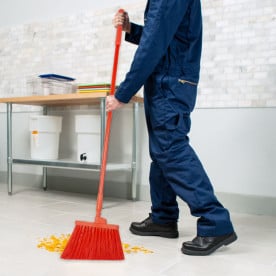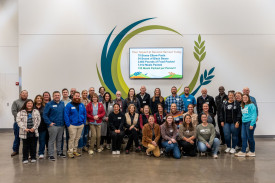Safety & Personnel

- May 01, 2019
Nelson-Jameson has expanded their color-coded program once again with the release of their 2019 Color-Coded Catalog. This year's catalog has grown to 56 pages of products that help to prevent allergen migration and cross-contamination. From the lab to the processing line, Nelson-Jameson has the color-coded products you need to produce safe, quality food.
In addition to having the most extensive color-coded program in the industry, we also have the most color options! Nelson-Jameson is now proud to offer gray, brown and lime products from Remco/Vikan® to help meet all your color-coded needs. The expanded catalog also includes new items like Color-Coded Cable Ties, Flagged Angle Brooms, Nylon Scrapers and more!
- April 05, 2019
Selecting footwear with the correct outsole design is one of the first steps to help prevent slips and falls in the workplace. The type of flooring as well as the contaminants on the floor need to be taken into consideration when thinking about slip resistance. Where water or liquid contaminants are present, a boot with a less aggressive tread with a greater amount of surface contact may be a better option, while a floor that has debris present will require a more aggressive tread pattern to be able to cut through the debris and make contact with the floor. Below is a brief description of the different outsole patterns available.
- April 01, 2019
Marking and identification of contents in pipes and piping systems is important for both safety and maintenance. Pipe markers are used to visibly identify contents, flow directions, and hazard classification, thus promoting a safe working environment. Use the below legend and information to help you choose the correct pipe marker for your application.
- November 03, 2014
Here are some helpful tips to remember when using ice melt to prevent icy sidewalks and driveways.
Use It!
Whether it is in an effort to save money or time, skipping ice melt means that you are setting yourself up for slippery sidewalks, entryways and parking lots. This could be an expensive mistake for your company.
Don't Use Too Much
Evenly spread application is essential for optimal melt. Applying ice melt using a spreader ensures even application,
while scoops and shovels are most common, they can cause overuse or piling in areas.Know When To Apply
Todd Spencer, former National Sales Manager for North American Salt, is quoted saying "pre-application is ideal as an initial deterrent before the snow falls, though it is often difficult to predict necessity." Ice melt
- April 23, 2014
Welcome to a comprehensive list of safety and personnel terminology, compiled for your reference by Nelson-Jameson. This compilation covers a diverse range of terms relevant to safety in the workplace. Whether you're familiarizing yourself with industry standards like ANSI (American National Standards Institute) or exploring the characteristics of various materials such as Kevlar, Neoprene, and Nitrile, this list aims to enhance your understanding of safety-related concepts. From sole designs like Chevron and Chevron Plus to regulatory bodies like FDA (Federal Food & Drug Administration) and OSHA (Occupational Safety & Health Administration), each term is accompanied by concise explanations to facilitate clarity. Whether you're a seasoned professional or new to the realm of safety and personnel, this collection provides valuable insights into the essential terminology that underpins a safe and secure working environment.
- April 23, 2014
The Cut-Resistant Glove Selection Guide is a resource that evaluates the abrasion, cut, tear, and puncture levels of various glove materials. This guide serves as a tool for individuals seeking to make informed decisions about the most suitable cut-resistant gloves for their specific applications. By utilizing the Cut-Resistant Glove Selection Guide, users can gain insights into the unique properties of different materials, allowing them to match the gloves to the precise requirements of their work environments. This guide provides essential information to ensure optimal hand protection. Make use of this guide to navigate the complexities of cut-resistant gloves and choose the ones that best align with your application's needs.
- April 23, 2014
Experience enhanced precision and clarity in cut resistance standards with the introduction of the new ANSI standard, featuring nine distinct cut levels. This progressive update significantly narrows the gaps between each level, offering a more refined and precise categorization for cut-resistant gloves and sleeves, particularly those with the highest gram scores.
The accompanying graph illustrates the discernible difference between the old scale and the new scale, providing a visual representation of the improved granularity in cut level classification. Notably, the new ANSI cut scores will bear an "A" prefix, further distinguishing them from the previous standards. Embrace the heightened accuracy and specificity of the updated ANSI standard, ensuring a more nuanced understanding and selection of cut-resistant gear tailored to your specific safety requirements.
- April 23, 2014
The Hazard Communication Standard (HCS) (29 CFR 1910.1200(g)), revised in 2012, requires that the chemical manufacturer, distributor, or importer provide Safety Data Sheets (SDSs) (formerly MSDSs or Material Safety Data Sheets) for each hazardous chemical to downstream users to communicate information on these hazards. The information contained in the SDS is largely the same as the MSDS, except now the SDSs are required to be presented in a consistent user-friendly, 16-section format. This brief provides guidance to help workers who handle hazardous chemicals to become familiar with the format and understand the contents of the SDSs.
Section 1: Identification
Section 2: Hazard(s) Identification
Section 3: Composition/Information on Ingredients
Section 4: First-Aid Measures
Section 5: Fire-Fighting Measures
Section 6: Accidental Release Measures
Section 7: Handling and Storage
Section 8: Exposure Controls/Personal Protection







